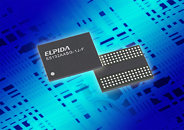Thursday, May 15th 2008
Elpida Offers Industry's First DDR2 SDRAM with x32-bit I/O Configuration
Elpida Memory, Japan's leading global supplier of Dynamic Random Access Memory (DRAM), today announced the availability of the industry's first 512-megabit DDR2 SDRAM with x32-bit I/O configuration. Elpida will begin sampling of this product by the end of this month.In the past a DDR2 controller with x32-bit wide interface required two x16-bit I/O DRAMs. Now, Elpida offers a 512-megabit DDR2 SDRAM with x32-bit I/O configuration as a one-chip solution. The advantages of this x32-bit solution over a two 256-megabit DDR2 (with x16-bit configuration) solution are as follows:
Elpida developed x32-bit I/O DDR2 products to meet the need for small-size consumer electronics that feature 1.8V low-voltage operations and low-power consumption. Because the new x32-bit product is specially designed for consumer devices it is well suited for use in digital consumer appliances.
Product Features:
Digital TVs, set-top boxes (STB), personal navigation devices (PND), printers, digital still cameras, digital video recorders, projectors and more.
Mass production of the new x32-bit DDR2 SDRAM is scheduled to begin in September 2008. Because Elpida has a proven track record of device production and support for early product launches in the digital consumer market, more than 30 companies in Japan and elsewhere in Asia, North America and Europe have welcomed the product. As a result, business discussions are in progress.
Source:
Elpida
- Approximately 25% memory area reduction on the board
- Fewer package balls (40 balls)
- Approximately 20% less power consumption
- A one-chip solution delivers low EMI and better signal quality
Elpida developed x32-bit I/O DDR2 products to meet the need for small-size consumer electronics that feature 1.8V low-voltage operations and low-power consumption. Because the new x32-bit product is specially designed for consumer devices it is well suited for use in digital consumer appliances.
Product Features:
- 512Mbit DDR2 SDRAM (x32-bit I/O configuration) using 70nm process technology
- Data transfer rate: 250Mbps to 1066Mbps (1GBytes/sec to 4.2GBytes/sec per DRAM device)
- ODT (On-Die-Termination): 50/75/150/225ohm
Enhanced 225ohm ODT reduces power consumption - Driver strength: normal/weak/quarter
Reduces overshoot, undershoot noises
Digital TVs, set-top boxes (STB), personal navigation devices (PND), printers, digital still cameras, digital video recorders, projectors and more.
Mass production of the new x32-bit DDR2 SDRAM is scheduled to begin in September 2008. Because Elpida has a proven track record of device production and support for early product launches in the digital consumer market, more than 30 companies in Japan and elsewhere in Asia, North America and Europe have welcomed the product. As a result, business discussions are in progress.

10 Comments on Elpida Offers Industry's First DDR2 SDRAM with x32-bit I/O Configuration
EDIT
If so, it will be easier to OC due to the RAM not heating up as much. Add that to this:And you got a win / win situation here!
Hopefully cheaper than current prices too...well we can hope, and i would imagine the heat spreaders would perform better or use less material to lower prices.
Gam
Right now your typical dram consists of 8x16M = 64 bit path for the memory module.
These new chips will be able to get 128 per module. So we could be looking at a future path to 256 and 384 bit DDR 2/3 Possible DDR4. For desktops.
Awesome stuff
FTA:
Target Market:
Digital TVs, set-top boxes (STB), personal navigation devices (PND), printers, digital still cameras, digital video recorders, projectors and more.
but"guess we wont be getting these anytime soon